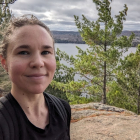Support strong Canadian climate journalism for 2025
These in-their-own-words pieces are told to Patricia Lane and co-edited with input from the interviewee for the purpose of brevity.
Lesley Johnson creates maps to help us explore Canada’s nature trails. As manager of geographic information system (GIS) mapping for Trans Canada Trail, this 31-year-old Montrealer leads a team that provides decision-makers with advice about existing trail maintenance and enhancement, and new trails.
Tell us about your work.
Trans Canada Trail looks after over 28,000 kilometres of nature trails connecting Canada’s three coasts. We make it increasingly easy for the public to enjoy them. This might involve adding culturally relevant information at places along the trail - for example, the history of Black people in Canada. Or we might display some history of the Lachine Canal beside it on the trail. We also provide decision-makers with information about which parts of the trail can be made more accessible to persons with disabilities.
We identify gaps in the network with the goal of making it available to everyone.
Maintaining a network this large requires significant resources. We collect information about where repairs or maintenance are needed. Our work is made even more challenging by erosion or destruction caused by forest fires, flooding and other climate impacts. Sadly, sometimes we must map an area as closed to the public for these reasons.
My team uses a combination of open GIS data and local knowledge to ensure the information is as up to date and accurate as possible.
How did you get into this work?
My mom is a forester. She used paper maps and desktop GIS programs to build sustainable forest management plans in northern Ontario. I grew up understanding that visually displayed data, such as maps, can influence decision-makers in a way that data or stories alone sometimes cannot. I studied environmental science and GIS at McGill and am very happy to be able to apply my knowledge and skills in this job.
What makes it hard?
People know that technology has the capacity to help us understand our world but are often not clear about the work needed to generate the data. I have had to learn that not every request that comes across my desk is a priority. It can also be challenging to help others understand the limits to the conclusions we can draw from the information that is available.
Data can be misused. For example, if a portion of a trail is close to a site of importance to Indigenous people, it is necessary to ensure the map made available to the public reflects these sensitivities.

What do you have as your vision if we get this right?
There is very good data that time outside in nature is good for our physical and mental health. Embracing support for, and use of our trail system speaks of a culture that understands it is in our collective interest to make that available for everyone.
How does the way you were raised affect you?
Both my parents are scientists caring for the natural world. I was raised in a small northern town where a connection to the land and between the people living on it are a way of life. Living in a large city and working remotely means I have had to learn to be intentional about creating a sense of community. One way I do that is by taking care of a very small patch of land in the neighbourhood. It is amazing how many people come to chat even if all I am doing is raking leaves.
I love cycling the trails near me. I know well that being outside, even for a short while, can lift my mood.
What advice would you give other young people?
If you are unsure about how to help, start by learning about how global heating is affecting places you love and what people in your community are doing about it. As you become more aware, it will become more evident how to use your own talents and skills. I would never have thought to learn GIS mapping if I hadn’t seen the influence it gave my mother as she sought to protect the forests she loves.
You don’t have to be excellent at everything all the time to make a difference.
What about older readers?
Take your kids and grandchildren outside and use our trails. Being comfortable outside is part of becoming resilient. When we pay attention, we do notice more losses, but we can also come to the wonder of what remains. You and your children will feel better and be motivated to protect the places you love.







Comments